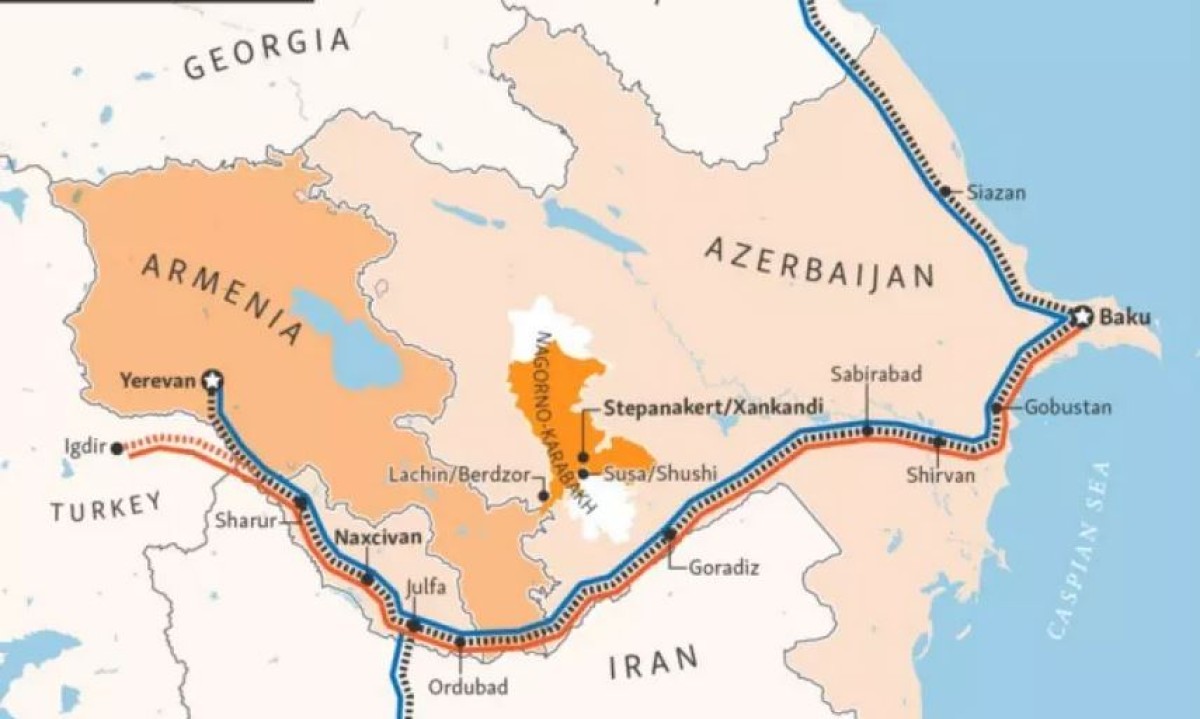 531
531
The Strategic Calculations Behind Iran’s Aras Corridor: An Alternative to the Zangezur Crisis?
The Strategic Calculations Behind Iran’s Aras Corridor: An Alternative to the Zangezur Crisis?
By: M. Sharifi
In recent developments, Iran and Azerbaijan have taken a decisive step in regional diplomacy with the establishment of the "Aras Corridor." This transit route has now become a critical component in the geopolitical landscape of South Caucasus relations, particularly between Tehran and Baku.
The Aras Road Corridor, which cuts through Iran’s East Azerbaijan Province, connects the village of Aghband in the southwestern corner of Azerbaijan's Zangilan district to the city of Ordubad in southern Nakhchivan. Crucially, this corridor bypasses Armenia, positioning itself as a potential substitute for the contentious Zangezur Corridor, thereby addressing some of Iran's longstanding concerns about its shared border with Armenia.
Iran's Position in the South Caucasus: Preserving Borders with Armenia
For Iran, the border with Armenia is not merely a geographical fact but a strategic linchpin that connects it to the northern reaches of Eurasia. This border serves as a gateway for trade with the Eurasian Economic Union (EAEU), a crucial factor in Iran’s foreign policy calculus. Iran's diplomatic and strategic maneuvers in the South Caucasus, particularly its emphasis on preserving Armenia's territorial integrity, underline Tehran’s commitment to maintaining its northern economic corridors. The Armenian province of Syunik, in particular, holds immense importance as it is the region most vulnerable to Azerbaijani ambitions.
In a clear signal of this commitment, Iran opened a consulate in the Armenian city of Kapan in October 2022. This move was widely seen as a stern message to Azerbaijan, signaling that Tehran would not tolerate any attempts by Baku to exert control over Armenia by force. Additionally, during a meeting between Iran’s Supreme Leader Ayatollah Ali Khamenei and Armenian Prime Minister Nikol Pashinyan, Khamenei reiterated Tehran's opposition to the Zangezur Corridor project, which he described as contrary to Armenia’s national interests.
This diplomatic message to Armenia was far from subtle. In the face of mounting pressure on Yerevan, particularly amid whispers of Armenia’s potential acquiescence to the Zangezur Corridor through Pashinyan's “Crossroads of Peace” initiative, Khamenei’s words reaffirmed Iran’s stance. Tehran’s position remains unequivocal: any project that undermines Armenian sovereignty is a direct threat to regional stability.
Domestic and Regional Significance of the Aras Corridor
The Aras Corridor stands as a pivotal project, one that has the potential to stabilize the region while advancing the economic interests of multiple players. By bypassing Armenia’s disputed Syunik region—where Azerbaijan has expressed an intent to carve out the Zangezur Corridor—the Aras Corridor may diminish tensions and create an environment more conducive to diplomatic engagement. In doing so, this transit route serves as a significant milestone in reshaping the regional dynamics of the South Caucasus.
The strategic importance of the South Caucasus cannot be overstated. Geographically, it is a critical node in international transit routes for both goods and energy. Iran, with its keen eye on economic revitalization, views the Aras Corridor as a potential boon for the Aras Free Zone. This area could become Iran’s most industrialized free zone, fostering greenhouse agriculture and supporting industrial, agricultural, tourism, and commercial sectors. The corridor holds the promise of restoring the region's historical role as a vital artery in Iran’s trade and transit network.
However, the benefits of the Aras Corridor are not guaranteed. One of Iran's primary motivations for completing the transit route from Azerbaijan to Nakhchivan through its own territory is to reduce Baku's incentive to force a transit route through Armenia. Should Armenia and Azerbaijan finalize a peace treaty, and diplomatic ties are restored between Armenia and Turkey, the strategic value of the Aras Corridor could be diminished. The corridor's relevance is tightly linked to the geopolitical state of the region, particularly Armenia’s internal political dynamics. If the nationalist and conservative factions in Armenia rise to power and oppose peace with Azerbaijan and Turkey, the status quo might persist. But if Pashinyan’s government endures and normalizes relations with its neighbors, the Aras Corridor’s significance may wane.
Navigating the Future
The Aras Corridor’s potential to connect Azerbaijan to Nakhchivan through Iranian territory by both road and rail holds immense promise. The revival of a Soviet-era line, which once passed through the Jolfa-Jolfa border, could provide an alternative to the Zangezur Corridor, alleviating Iran’s concerns about its shared border with Armenia. Yet, the corridor's future hangs in the balance, tethered to the evolving diplomatic landscape of the South Caucasus.
Ultimately, Iran’s strategic play with the Aras Corridor is emblematic of its broader geopolitical ambitions. As Tehran seeks to navigate the complex web of alliances and rivalries in the South Caucasus, the future of this corridor—and the region as a whole—will depend on the shifting sands of diplomacy, regional stability, and the political calculus of its neighbors.
 531
531
Comment
Post a comment for this article